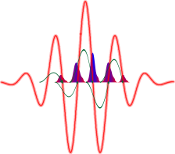|
 The rapid development of laser technology provides higher and higher laser intensities opening up completely new fields of research. In many laser research laboratories today it is straightforward to generate laser fields of such high intensities that the strength of the electric field is comparable to the Coulomb field of the atom bounding their electrons to the ground state. High intensity (1014 W/cm2) lasers are able to pull away the electrons of an atom or molecule (optical ionization), and accelerate these free electrons. The electrons wiggling in the sinusoidal field of the laser can return to the ion core. Upon return, recombination can take place, releasing the electron’s kinetic and potential energy in form of a single, high-energy photon.
The rapid development of laser technology provides higher and higher laser intensities opening up completely new fields of research. In many laser research laboratories today it is straightforward to generate laser fields of such high intensities that the strength of the electric field is comparable to the Coulomb field of the atom bounding their electrons to the ground state. High intensity (1014 W/cm2) lasers are able to pull away the electrons of an atom or molecule (optical ionization), and accelerate these free electrons. The electrons wiggling in the sinusoidal field of the laser can return to the ion core. Upon return, recombination can take place, releasing the electron’s kinetic and potential energy in form of a single, high-energy photon.
Since 1987 it is known that the previously described process, when taking place in noble gas atoms, generates high-order harmonics of odd orders of the fundamental laser field. The high central frequency of the high-harmonic spectrum, together with its large bandwidth (harmonics of orders higher than a hundred can be generated this way) provides the possibility of generating extremely short, attosecond pulses (10-18 s). Research in the field of attosecond pulse generation gained new momentum in 2001, when experimental evidence proved the existence of attosecond pulses. Since then, this field is in focus of many research groups with rapidly advancing the optimization of attosecond pulse and pulse train generation, with the ultimate goal of applying these in studies of atomic and molecular processes.
The attosecond time scale is the natural time scale of the evolution of electron wavepackets in atoms and molecules. Attosecond pulses provide the tools to study and control these electronic processes giving birth to the research field of attosecond physics.
ELI-ALPS in Szeged
 The relevance of local attosecond physics research increased even further with the decision of building the largest attosecond research facility, the Extreme Light Infrastructure – Attosecond Light Pulse Source (ELI ALPS) in Szeged.
The relevance of local attosecond physics research increased even further with the decision of building the largest attosecond research facility, the Extreme Light Infrastructure – Attosecond Light Pulse Source (ELI ALPS) in Szeged.
|